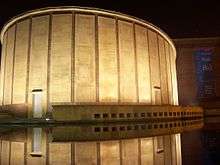Kleinhans Music Hall
|
Kleinhans Music Hall | |
|
Kleinhans Music Hall | |
  | |
| Location | Buffalo, New York |
|---|---|
| Coordinates | 42°54′07″N 78°53′01″W / 42.90194°N 78.88361°WCoordinates: 42°54′07″N 78°53′01″W / 42.90194°N 78.88361°W |
| Built | 1938-40[1] |
| Architect |
Eero Saarinen Eliel Saarinen[1][2] |
| Architectural style | International Style[2] |
| NRHP Reference # | 89001235 |
| Significant dates | |
| Added to NRHP | June 29, 1989[2][3] |
| Designated NHL | June 30, 1989[4] |
Kleinhans Music Hall, home of the Buffalo Philharmonic Orchestra, was built in the late 1930s and opened October 1940. It is located on Symphony Circle in Buffalo, New York. The music hall was built as a part of the last will and testament of Edward L. and Mary Seaton Kleinhans, owners of the Kleinhans men's clothing store. The couple left close to 1 million dollars for the music hall's construction. The building was designed by Eliel Saarinen with his son, Eero Saarinen and "was recognized as one of the greatest concert halls ever built in the United States".[5] It was declared a National Historic Landmark in 1989[4][6] and "is renowned for its acoustical excellence and graceful architecture."[7]
History

In 1934, when it was determined a music hall was to be built, it was assumed the much experienced and local architect, Edward B. Green would get the job. In 1935, Green submitted a neoclassical design combining the styles of Symphony Hall in Boston and Severance Hall in Cleveland. Green planned to have the hall attached to the Museum of Science. It was later decided the hall would be constructed at the site of Truman Avery's mansion (to be demolished) on the circle at Richmond and Porter Avenues (known as Symphony Circle).[5]
George F. Rand, the chairman of the Buffalo Foundation (the Kleinhans' executors), liked the works of local architects and brothers, F.J. and William Kidd. (The Kidd brothers designed Buffalo's Rand Building, built in 1929 and located at Lafayette Square). In May 1938, the brothers were hired as architects for the music hall. However, their designs were criticized by Esther Link who had been shown the Kidd drawings by Buffalo Foundation lawyer, Edward P. Letchworth. Link, without any formal architectural education, was a high school music teacher who travelled Europe and had a strong background with architects and artists. She was an admirer of architect Eliel Saarinen particularly for his design of the central railroad terminal in Helsinki. In July 1938, upon Letchworth's request, Link drafted a letter detailing her passion for Saarinen's work and the future of Kleinhans music hall. The Buffalo Foundation agreed to offer Saarinen the position of consultant. Saarinen declined. Letchworth did not want to undermine Rand and the Kidd brothers. In September 1938, Letchworth met with Saarinen and his son Eero, and the Kidd Firm. They all agreed that Saarinen would be "designing architect" while Kidd would oversee the project. Saarinen quickly submitted his design one month later.[5]
When completed, the cost of the Hall reached $1,500,000,[8] and included funds from President Roosevelt's Public Works Administration in addition to the $1,000,000 from the estate of Edward L. and Mary Seaton Kleinhans.[9] Kleinhans opened October 19, 1940 with a concert by the Buffalo Philharmonic under Maestro Franco Autori.[8]
Notable events
On November 13, 1949, Margaret Truman, President Truman's daughter, performed in front of a crowd of 1,800 at Kleinhans with the Buffalo Philharmonic Orchestra. She performed Mozart's Dove Song from The marriage of Figaro, Glazunov's "La Premavare", and "O Mio Bambino" from Puccini's Gianni Schicchi as an encore.[10]
On November 9, 1967, four months after the city was rocked by the Buffalo riot, Dr. Martin Luther King visited Kleinhan's and in a speech titled "The Future of Integration" before about 2,500 persons and sponsored by the Graduate Student Association at the University at Buffalo proclaimed: "We are moving toward the day when we will judge a man by his character and ability instead of by the color of his skin."[11]
On September 8, 1964, Robert F. Kennedy, then the Democratic candidate to become a United States Senator from New York, gave a speech at Kleinhans in front of a crowd of 6,000 people. The campaign event took place just 10 months after President John F. Kennedy was assassinated in Dallas.[12]
References
- 1 2 "Kleinhans Music Hall". Buffalo Architecture and History. 2007-02-23.
- 1 2 3 "National Register of Historical Places - New York (NY), Erie County". National Register of Historic Places. National Park Service. 2007-02-23.
- ↑ National Park Service (2007-01-23). "National Register Information System". National Register of Historic Places. National Park Service.
- 1 2 "Kleinhans Music Hall". National Historic Landmark summary listing. National Park Service. 2007-09-15.
- 1 2 3 City on the Edge, Buffalo, NY. Goldman, Mark. 2007.
- ↑ Carolyn Pitts (February 9, 1989). "National Register of Historic Places Inventory-Nomination: Kleinhans Music Hall" (PDF). National Park Service. and Accompanying 4 photos, plan, exterior, and interior, from c.1938, c.1945 and 1978. (1.24 MB)
- ↑ "More in Buffalo". The New York Times. 1 August 1993. Retrieved 14 October 2016.
- 1 2 "WITH SOME ORCHESTRAS". The New York Times. October 6, 1940. Retrieved 14 October 2016.
- ↑ "ICKES RAPS NAVY CRITICS | At Buffalo He Credits PWA for Naval Outlay of Billion". The New York Times. October 15, 1940. Retrieved 14 October 2016.
- ↑ "1,800 HEAR MISS TRUMAN | She Appears in Buffalo Concert With That City's Philharmonic". The New York Times. November 14, 1949. Retrieved 14 October 2016.
- ↑ "Massive Action Urged: King Says Negro In Economic Trap," by Richard E. Baldwin, Buffalo Courier-Express, November 10, 1967 [accessed 7/16/2008, http://www.buffalonian.com/hnews/1967mlkinginbuffalo.html]
- ↑ Westmoore, Jean (1 September 2016). "Sept. 8, 1964: Bobby Kennedy wows crowd at Kleinhans". The Buffalo News. Retrieved 14 October 2016.
External links
- Website
- Information from Buffalo Philharmonic Orchestra
- Kleinhans Community Association
- Dr. Martin Luther King, Jr. at Buffalo


